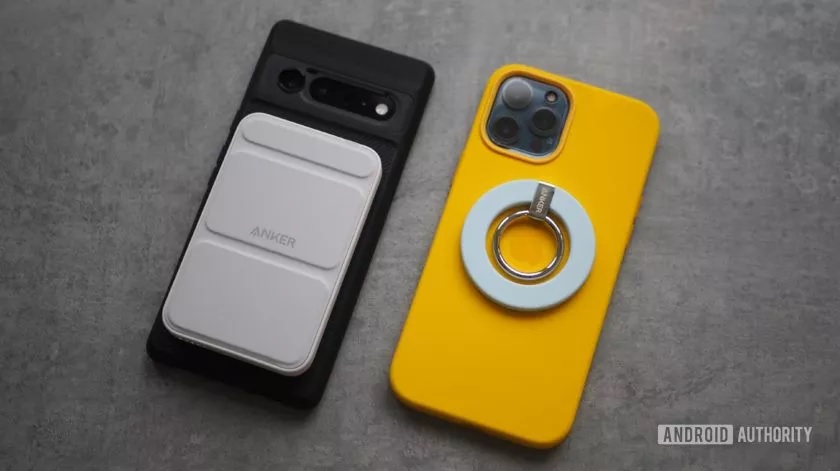자료실
[해외칼럼]무선충전 표준 Qi2 발표, Magsafe와의 차이점은?
- 작성일2023/03/21 16:30
- 조회 3,211
[2023-06-08] 해당칼럼에 대한 질의의견이 있었고, 본 칼럼내용 중 일부내용이 사실과 다름을 확인하였습니다.
> 본 칼럼에서 호환성이 보장되지 않는 이유로 "Qi2와 MagSafe의 자석배열이 다름"을 제시한 부분은 사실이 아님을 확인하였습니다. Qi2 규격문서는 WPC 회원사에 한하여 올 하반기 Qi2 런칭 시 확인하실 수 있습니다.
> Qi2와 관련된 WPC의 공식적인 입장은 WPC의 보도자료를 통해 확인하실 수 있습니다. (주소: https://www.wirelesspowerconsortium.com/about/press)
- 칼럼 본문 -
CES 2023에서 Wireless Power Consortium(WPC)은 Qi의 후속인 Qi2를 발표했습니다.
Qi2는 새로운 기기에 대한 지원 뿐만아니라, 코일을 정확하게 정렬하기 위해 자기 전력 프로파일(Magnetic Power Profile)기술을 도입했습니다.
자기 전력 프로파일은 Apple의 Magsafe와 매우 흡사한데, 실제로 Apple은 WPC의 회원으로 2023년 중반에 완성 예정인 Qi2 표준 업데이트의 주요 기여자일 것입니다.
그렇다면 Magsafe가 Android로 출시된다는 뜻일까요?
- Android용 Magsafe와의 상호 운용성
Qi2는 본질적으로 안드로이드용 Magsafe라고 볼 수 있습니다.
자기 전력 프로파일은 더 이상 Apple 제품에만 사용하는 기술이 아니며, 자석 무선 충전, 기타 액세서리를 다양한 스마트폰과 주변기기에 장착할 수 있습니다.
이미 시중에는 다양한 Magsafe 충전기와 자석 액세서리가 있지만, 일부 제품과는 호환하지는 않으며, 특히 무선 충전은 인증이 보장되지 않았습니다.
Apple 제품 이외의 통일된 표준이 없어 상호 운용성을 해치고 있습니다.
Qi2는 모두가 사용할 수 있는 Magsafe지만, Apple의 Magsafe와는 몇 가지 차이점이 있습니다.
Qi2는 자석 부착을 표준화하고, 다양한 제품 간의 호환성을 보장해줍니다.
WPC는 Qi2 인증 제품이 브랜드 사이에 안전하고 효율적으로 상호 운용이 가능하다는 것을 보증하고 있습니다.
여전히 주로 사용하는 장치는 스마트폰이지만, 평면 대 평면 장치로 충전할 수 없는 장치를 충전할 수 있게끔 설계되어 있습니다.
예를 들면, 웨어러블이라 AR/VR 헤드셋 같은 형태도 충전이 가능합니다.
Qi2는 유선 충전이 USB-C 타입으로 단일화된 것처럼, 무선 충전 영역의 단일 표준을 목표로 하고 있습니다.
단일화는 편의성뿐만 아니라 전자 폐기물, 충전기 구입 비용 등 여러 가지 측면에서 매우 바람직합니다.
- Qi2 vs Apple Magsafe : 동전의 양면
Magsafe 기술을 기반으로 동일한 15W의 전력을 사용하지만, Qi2와 Magsafe 자석 레이아웃이 다르기 때문에 두개는 별개의 표준입니다.
Mafsafe와 차이점이 있으며, Magsafe는 당분간 자체적으로 유지될 것입니다.
Qi2와 Apple Magsafe는 자석 패턴이 동일하지 않기 때문에, 새 표준이 기존 아이폰 모델과 액세서리를 지원할 가능성은 작습니다.
Apple이 가까운 시일 내에 Magsafe 표준을 포기하지 않을 것이기 때문에, 두가지 표준이 상호 호환된다는 것이 증명되지 않는 한, 자석 부품이 제대로 작동하지 않을 수도 있습니다.
Qi2 장치 송신기가 인증을 위해 핸드셰이크를 진행하는데, 인증되지 않은 제품이라면 제대로 작동하지 않을 것입니다.
이는 미인증된 장치 단속을 가능하게 하지만, 소비자들이 어떤 액세서리가 스마트폰과 웨어러블에서 올바르게 작동하는지를 모르게 할 수 있습니다.
Qi2의 목표는 훌륭하지만, 하위 호환 없이 어떤 표준을 다른 표준으로 대체하는 것은 새로운 문제가 발생할 수 있습니다.
- Qi와 Qi2의 차이점
지금까지 살펴본 바와 같이, 주요 차이점은 자기 전력 프로파일의 도입입니다.
Qi2는 스마트폰과 기타 웨어러블이 충전기와 정확하게 정렬되도록 보장하며, 이전과 동일하게 이물질 감지 기능도 포함되어 있습니다.
둘째, Qi2는 일부 기기에서 더 빠른 무선 충전을 가능하게 할 것입니다.
Qi2는 현재 15W로 기존 Qi과 동일하게 전력이 제한됩니다.
그러나 iPhone을 포함한 많은 Qi 지원 제품들은 7.5W의 전력으로 제한되고 있습니다.
Qi2는 자석 코일로 설계되어 에너지 효율을 개선하고 무선 전력 손실을 줄이므로 충전 속도가 향상될 수 있습니다.
Qi2가 2023년 중반에 완성된다면, WPC 더욱 강력한 전력을 제공할 것으로 보이지만 정확히 어느 정도인지는 아직 밝히지 않았고, 우리는 적어도 2024년까지는 기다려야 할 것 같습니다.
[칼럼원문] 작성자 : Robert Triggs, 출처 : https://www.androidauthority.com/qi2-magsafe-for-android-3262341/ 에서 일부 내용을 발췌했습니다.
Does Qi2 mean MagSafe is coming to Android?

Hot off the press from CES 2023, the Wireless Power Consortium (WPC) announced Qi2 — the successor to the popular Qi wireless charging standard.
Not only does Qi2 (pronounced chee two) bring additional consumer clarity around device support, but it also introduces a new Magnetic Power Profile to align coils and help empower accessories.
If all that sounds familiar, it is. Apple’s Magsafe is a very similar idea. In fact, Apple is a “steering” member of the WPC and would have been a major contributor to this new specification,
which is due to be finalized in mid-2023. So does this mean that Magsafe is coming to Android? Well, yes and no.
Solving interoperability with Magsafe for Android
In terms of what consumers can expect, Qi2 is essentially Magsafe for Android.
In fact, it’s more like Magsafe for everyone. The idea is no longer limited to Apple’s ecosystem,
enabling magnetic wireless charging and other accessories to snap to the back of your future smartphone and an assortment of other gadgets.
But aren’t there already Magsafe and magnetic accessories for a range of phones?
Well, yes, but it’s a Wild West of adapters that don’t always play nicely with other products and certainly don’t guarantee the intended user experience, especially when it comes to wireless charging.
However, the lack of a unified standard outside of the Apple ecosystem is not ideal and is hurting interoperability.
Qi2 is essentially Magsafe for everyone, but there are a few differences.
Enter Qi2, which will standardize the magnetic attachment and help ensure compatibility across a wide range of products and even ecosystems.
The WPC states that this standard specifically targets consumer confusion issues over Qi certification, ensuring that certified products are safe, efficient,
and interoperable across brands.
Although still primarily targeting phones, the new standard is also designed with accessories that aren’t chargeable using current flat surface-to-flat surface devices.
That sounds like great news for wearables, for instance, and more oddly shaped devices like AR/VR headsets.
After many years, USB-C has finally established a consensus around wired charging (except for Apple’s iPhone), allowing multiple gadgets to charge via a single shared connector interface.
Qi2 aims to achieve the same in the wireless domain, and there’s no denying that a single wireless connector for phones, smartwatches, and other accessories would be hugely desirable.
Not only from a convenience perspective but from e-waste, cost, and travel standpoints as well.
Qi2 vs Apple Magsafe: Two sides of the same coin
Although based on Magsafe technology and sporting the same 15W power,
Qi2 has a different magnet layout and is a separate standard from Apple’s Magsafe.
Although Apple has contributed some of its insight and technology to Qi2, this isn’t strictly a universal Magsafe standard.
There remain some key differences, and Magsafe will remain its own thing for the time being.
Qi2 and Apple Magsafe don’t feature the exact same magnet pattern, so it seems unlikely that the new standard will support existing iPhone models and accessories.
hat’s a worry because Apple may not necessarily abandon its standard in the immediate future, either.
There may be some lingering mess where magnetic accessories still don’t play nicely together, unless it turns out that the two are somehow cross-compatible.
In the draft specification, Qi2 device transmitters also have to handshake for authentication, meaning that uncertified products won’t work.
While that clamps down on the current disorganized state of affairs, it could also lead to further consumer confusion about which accessories will work correctly with their smartphone and wearables.
For instance, will that unofficial Magsafe product for your current phone work with a new Qi2 smartphone? That remains to be seen but seems doubtful.
While Qi2’s aims are noble, it’s not necessarily the cure-all we’d hoped for.
Simply replacing one standard with another can create new headaches, especially where there’s no backward compatibility.
What’s the difference between Qi vs Qi2?
As we’ve covered, the main difference is the introduction of the new Magnetic Power Profile.
Specifically, the new profile ensures that phones or other rechargeable battery-powered products are aligned perfectly with charging devices.
Qi2 also includes the same safety-oriented foreign object detection feature as its predecessor.
Secondly, Qi2 will enable faster wireless charging for some devices. Interestingly, Qi2 still provides the same maximum power level as its predecessor, which currently caps out at 15W.
However, many current Qi-capable handsets, including Apple’s iPhone, are limited to just 7.5W of power.
This will likely improve with Qi2, as the standard is designed with magnetic coil coupling in mind, improving energy efficiency and reducing power loss over the air.
In the longer term, the WPC will move to a more powerful wireless charging specification once Qi2 is complete in mid-2023.
Though the WPC hasn’t specified exactly how much power future versions of Qi2 will deliver. Either way, this improvement will form the basis for the next version of Qi2,
but that revision won’t appear until 2024 at the earliest.







